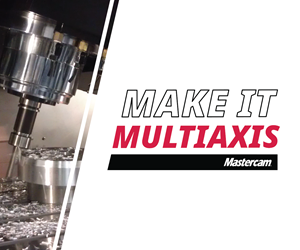-
SPONSORED
-
-
-
-
-
MMS Blog
Hard Turning And Cylindrical Grinding Were Made For Each Other
Combining different machining processes on the same platform has been a major theme in machine tool design for two decades or so. The Studer S242 combines cylindrical grinding and hard turning. A look at this machine shows that both of these machining processes benefit when they share the same platform.
Read MoreApplying A High Speed Machining Discipline Without The Speed
In this shop, high speed machining makes sense at 4,000 rpm. While the disciplines the shop put in place made a new 15,000-rpm profiler dramatically more productive, high speed machining would have remained valuable even if the new machine never came. Acoording to a co-owner of this shop, high speed machining has no need for speed.
Read MorePrecision Hole Making At High Cpk
Many shops and plants are moving from manual honing machines to CNC honing machines, as well as to robotically automated cells capable of controlling holes size to accuracies of 0.25µm (0.00001 inch). The inherent accuracy and process stability of honing have promoted this changeover because precision parts produced today must meet high Cpk requirements.Honing can produce a specified finish and a desirable crosshatch pattern on the bore surface, which helps retain a lubricating film for sliding components. Makers of outdoor power equipment, motorcycles, ATVs, hydraulics, pneumatics, gears, and valves are some of the users who have "discovered" automated honing in their drive to make parts with tolerances as tight as ±0.0002 inch (±5 µm) at high Cpk levels.
Read MoreThe Returns On Automation
Machine tool automation, particularly grinding machine automation, offers various returns on investment. Different shops notice different advantages, and sometimes shops overlook important benefits when they are deciding whether to automate.
Read MoreDirect Edge Finding Via Laser
A laser edge finder offers a direct method for locating workpiece edges that can save setup time.
Read MoreApplying Magnetism To Smooth Cutting Tools On A Grinding Machine
An alternate surface finishing device available on a tool grinding machine uses magnetism to swirl abrasive powder across the surface of a cutting tool. This creates a smooth surface finish and precisely rounded cutting edges.
Read MoreAnother Step Toward CAM Automation
A CAD/CAM software provider has taken an important step that will enable CNC machine tool users to benefit from emerging data-communications standards designed to promote a truly “paperless” manufacturing environment. The key is a STEP AP224 interface.
Read MoreGet Better Before You Get Bigger
Rather than making a major new machine tool purchase just yet, this shop is finding additional capacity on the equipment it already has. What once was a vertical machining center will become a flexible automated production center for unattended machining.
Read MoreMultitasking With A Small Footprint
The Integrex i-150 shows how a multitasking machine for small precision parts can combine done-in-one process with a compact structure to reduce floor space requirements. Most multitasking machines for parts of this size use a second spindle for endworking of parts after cutoff. This machine uses a swing-away workholding device instead.
Read MoreSmoothing Insert Surfaces Extends Tool Life
A post-coating finishing process smoothes any cracks in the outer coating of a cutting tool insert that develop during CVD and also removes droplets that PVD might leave behind. The resulting reduction in friction, heat and surface stresses is said to extend tool life and cutting performance.
Read MoreAn Alternate Route For Generating An Alternate Tool Path
A universal toolpath engine for roughing pockets optimizes cycle times by maintaining a constant material removal rate regardless of part geometry. This toolpath engine is not a CAM system. Instead, users pay a monthly fee to upload geometries to a secure Internet server and quickly receive tool paths that can be used with any CAM system.
Read MoreCreating Workpiece Blanks Via Adiabatic Cutoff
Adiabatic cutting is an alternative cutoff process for high-production machining applications. It uses kinetic energy to create a shockwave of sorts that softens a narrow, vertical plane through barstock material. The energy is converted into heat faster than the material being cut can dissipate it, and this controlled plastic deformation separates the material.
Read More








